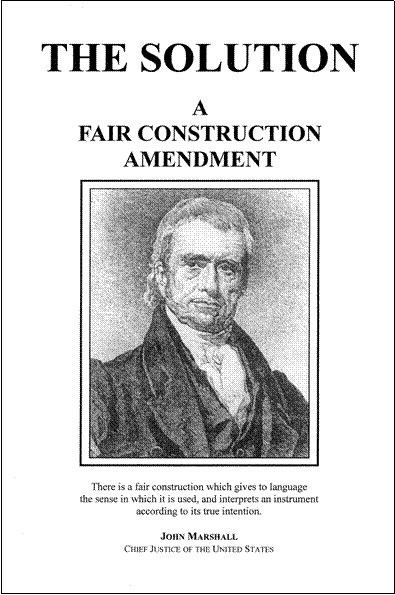
Critics of judicial activism have had very little success in reversing its effects, or even in slowing its further aggrandizement. So they’ve been casting about for new ways to curb our imperial judiciary.
WWW.FAIRAMENDMENT.US
| NEWS |

Critics
of judicial activism have had very little success in reversing its effects, or
even in slowing its further aggrandizement. So
they’ve been casting about for new ways to curb our imperial judiciary.
In 1996, for example, a measure to make Supreme Court decisions reversible by a congressional majority vote was proposed by no less a scholar than Robert Bork. “If constitutional jurisprudence remained a mess,” he wrote, “at least it would be a mess arrived at democratically.” But his proposal would have made the entire Constitution of no more force than any act of Congress. The idea went nowhere.
In 1997, Congressman Tom DeLay, who was then the House Majority Whip, called for impeaching some of the federal courts’ “particularly egregious” autocrats. That resulted only in a cascade of abuse against DeLay. He was denounced as a demagogic, ignorant, arrogant yahoo and compared to the extremist John Birch Society, which used to dot the countryside with “Impeach Earl Warren” billboards.
Then there are the many cases where a particular “landmark decision” provoked enough outrage to inspire calls for a specific amendment to undo it. At the federal level, none of those status quo ante amendments has succeeded; they’ve all been checked by the idea that adopting them would be tampering with the Bill of Rights. On such occasions, it seems not one American in a hundred manages to recall that the ruling in question has itself tampered with the Constitution. Not one in a thousand has any idea that such tampering was categorically denounced by the very men who gave us that document.
Today, friends of the real
Constitution, as opposed to the “living” one, put great hope in the changes that
may come to the high court through President Bush’s appointees. So far, Chief
Justice Roberts and Associate Justice Alito appear to be fulfilling Bush’s
promise to name only “strict constructionists.” But will they prove immune to
the temptation to “grow”
into the liberal establishment’s good graces and cross over to the activist
side? And even if they do stay true, does a reliance solely on judicial
appointments mount any real challenge to the idea that justices of various
persuasions are free to remake the Constitution in accordance with their
personal beliefs? As things stand, many of the court’s most destructive
precedents — its deterrence-impairing interference with the death penalty, for
example — are unlikely ever to be revisited, let alone reversed. More
importantly, our government remains one not of laws but of men. The meaning of
the Constitution still depends on the composition of the court.
But suppose the people
themselves intervened? Suppose we devised an amendment, based on the framers’
precepts, to make what Chief Justice John Marshall called “a fair construction”
of the Constitution not a theory in dispute but a positive requirement?
The Fair Construction Amendment and its sources